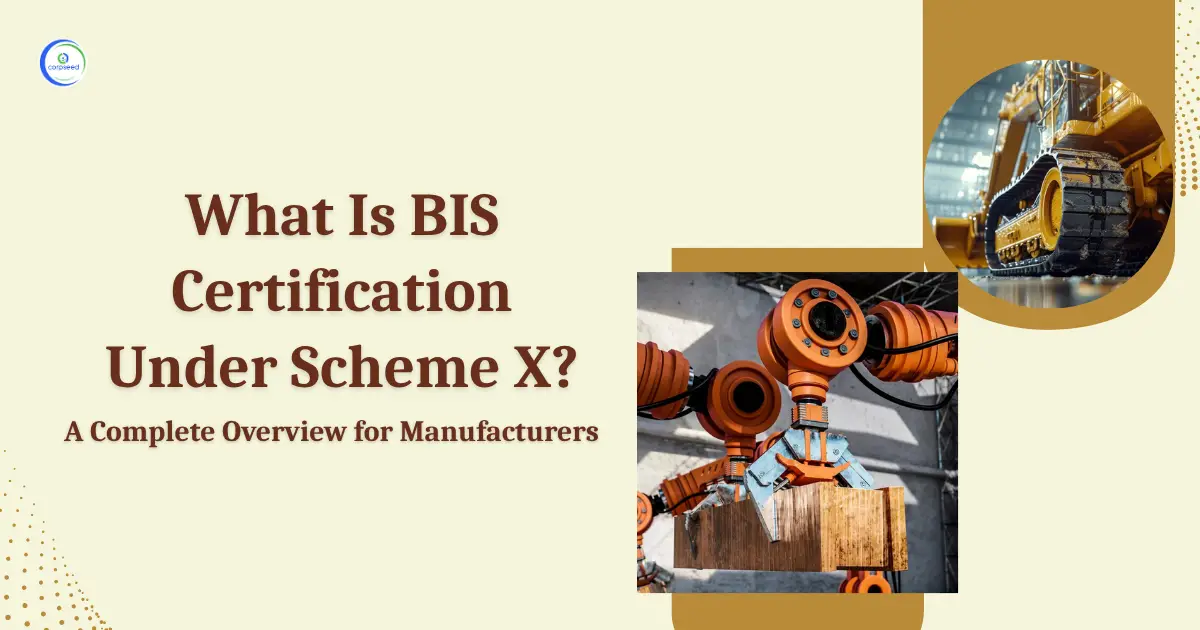The Bureau of Indian Standards (BIS) has officially released detailed guidelines for granting certification under Scheme-X for products covered under the Omnibus Technical Regulation (OTR). This certification process, as outlined in the BIS (Conformity Assessment) Regulations, 2018, helps manufacturers achieve BIS registration while ensuring that their products comply with the required machinery standards. Governed by the BIS Act, 2016, the BIS certification process ensures that products meet essential safety and quality standards, enabling them to carry the Standard Mark and be marketed with full confidence in the Indian market.
Table of Contents
- Overview of BIS Certification under Scheme-X for OTR Products
- Procedure for BIS Certification under Scheme-X
- Assessment Based on Technical Files
- Desk Audit and Site Audit
- Audit Procedure and Verification
- Handling Non-Conformities and Inadequacies
- Final Decision and BIS Certification Grant
- Rejection and Appeals Process
- BIS Certification for Foreign Manufacturers
- Fees and Financial Dues
- Conclusion
--------------Blog Contact Form-------------
Overview of BIS Certification under Scheme-X for OTR Products
The BIS Conformity Assessment Scheme-X is designed to ensure that products meet necessary machinery standards and safety regulations. Under this scheme, manufacturers can obtain two types of certifications:
- Licence to Use Standard Mark: This certification is typically valid for a specific period, ranging from three to six years. It allows manufacturers to use the BIS Standard Mark on their products.
- Certificate of Conformity: Issued for a specific batch, lot, or prototype of products, this certification has limited validity and applies only to the specified batch.
These certifications are essential for ensuring that products comply with the BIS guidelines 2025, helping manufacturers meet the requirements of the Omnibus Technical Regulation (OTR). The BIS registration obtained through this certification demonstrates that a product meets all necessary machinery standards, guaranteeing safety and reliability in the Indian market.
Procedure for BIS Certification under Scheme-X
The BIS certification process under BIS Scheme-X begins with the submission of an application by the manufacturer. The application form, as prescribed in Form-I, must specify whether the applicant is seeking the Licence to Use Standard Mark or the Certificate of Conformity. Along with the application, the manufacturer is required to submit a set of documents that provide detailed information about the product and its compliance with the relevant machinery standards.
The process follows the OTR certification rules for products covered under the Omnibus Technical Regulation (OTR). If the BIS guidelines 2025 do not explicitly address a particular issue, the BIS Act and other relevant regulations are applicable.
Assessment Based on Technical Files
The technical file plays a crucial role in the certification process. It contains all the necessary documentation that demonstrates that the product meets the prescribed safety and machinery standards. The technical file must include the following key elements:
- Product Description: A detailed description of the product, including its variety, grades, types, and sizes.
- Specified Requirements: The relevant machinery standards and essential safety requirements the product must meet.
- Photographs: Clear images of the product to facilitate easy identification.
- Manufacturer Details: Complete name and address of the manufacturer.
- Product Traceability: Information such as batch number, serial number, brand name, and manufacturing date.
- Design Details: Any design specifications or drawings that demonstrate the product’s compliance with machinery standards.
- Manufacturing Process: Detailed information about the manufacturing process.
- Compliance Report: A report detailing the risk assessments, safety functions, and the performance of safety-related parts.
The Product Compliance Report must include a hazard identification section and describe risk-reduction measures, such as engineering design, control systems, and product instructions. This section is essential for demonstrating the product’s compliance with the BIS machinery standards and safety requirements.
Desk Audit and Site Audit
Once the application and technical file are submitted, the certification process involves two crucial steps: the Desk Audit and the Site Audit.
- Desk Audit: The Desk Audit is the initial evaluation of the documentation submitted by the manufacturer. The audit checks if the application is complete and whether the product complies with the BIS guidelines 2025 and machinery standards.
- Site Audit: After the Desk Audit, a Site Audit is conducted to verify the manufacturer’s production facilities and ensure compliance with the technical file. The site audit usually lasts for about four mandays, depending on the complexity of the product and the number of technical files involved.
During the Site Audit, the auditors evaluate the manufacturing process, quality assurance measures, and infrastructure. The audit may also involve demonstrations of the product to verify that it complies with safety features and relevant machinery standards.
Audit Procedure and Verification
The Site Audit includes a verification process to confirm that the product complies with the specifications outlined in the technical file. This process includes the following activities:
- Safety Features Demonstration: Auditors may test the safety functions of the product, such as safeguarding devices or control systems, to verify compliance with machinery standards.
- Evaluation of Manufacturing Processes: Auditors review the entire manufacturing process to ensure that it aligns with the BIS machinery standards and quality assurance measures.
- Assessment of Infrastructure: Auditors check if the physical infrastructure at the production facility is adequate for producing products that meet safety and machinery standards.
Handling Non-Conformities and Inadequacies
If any non-conformities or inadequacies are found during the Desk Audit or Site Audit, the manufacturer will be notified and given a chance to resolve the issues. Some common reasons for rejection include:
- Incomplete Documentation: Missing or incomplete documents, or failure to respond to queries raised during the audit.
- Non-Conformity with Safety Standards: If the product does not meet the required machinery standards or safety regulations.
- Inadequate Corrective Actions: If the manufacturer fails to take corrective actions after receiving a notice or fails to meet compliance timelines.
Final Decision and BIS Certification Grant
After completing the technical evaluation and audits, and addressing all identified non-conformities, a final decision regarding the certification will be made. If the product complies with all necessary BIS guidelines 2025 and machinery standards, the Licence to Use Standard Mark will be granted for a period of three to six years.
If the applicant is unable to meet the requirements or fails to resolve outstanding issues, the BIS certification may be delayed or rejected. In such cases, the applicant will be informed of the reasons for the rejection and will have the opportunity to address the concerns.
Rejection and Appeals Process
Before issuing a rejection notice, the applicant will be given a 21-day notice period. During this period, the applicant can present their case, either in person or through a representative. After reviewing the applicant’s response, the BIS authority will make a final decision.
Common reasons for rejection include:
- Failure to Provide Corrective Actions: Not addressing the issues raised during the audits.
- Failure to Clear Financial Dues: Unpaid fees related to the BIS certification process.
- Tampered or Falsified Documents: Submitting fraudulent or altered documents.
If issues are not resolved within the given time frame, the application will be processed for rejection.
BIS Certification for Foreign Manufacturers
For foreign manufacturers seeking BIS certification, additional requirements apply, as specified. These requirements ensure a smooth process for certification and compliance with Indian machinery standards.
Fees and Financial Dues
All fees related to the BIS certification process, including those for the Desk Audit and Site Audit must be paid in advance. Failure to clear these financial dues may lead to the rejection of the application.
Conclusion
The BIS certification process under Scheme-X ensures that products meet the required machinery standards and safety regulations. By following the outlined procedure, manufacturers can achieve BIS registration, demonstrate that their products comply with BIS guidelines 2025 and meet the requirements of the Omnibus Technical Regulation (OTR). This certification process plays a key role in safeguarding consumer interests and ensuring that only compliant, safe products are available in the market. The BIS Standard Mark serves as a symbol of trust, ensuring that manufacturers meet the highest standards of quality and safety. By adhering to BIS guidelines, manufacturers can prevent delays and rejections, ensuring that their products successfully enter the market while complying with all necessary BIS regulations.
This portion of the site is for informational purposes only. The content is not legal advice. The statements and opinions are the expression of author, not corpseed, and have not been evaluated by corpseed for accuracy, completeness, or changes in the law.
BOOK A FREE CONSULTATION
Get help from an experienced legal adviser. Schedule your consultation at a time that works for you and it's absolutely FREE.








_CORPSEED.webp)
